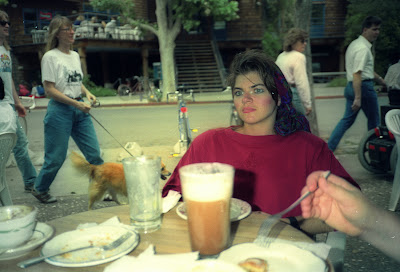 |
| The Golden Gate from the Palace of the Legion of Honor in San Francisco |
Berkeley had never been much of a town for motels, and to book ahead at the wonderfully convenient Durant Hotel I'd have to have known when we'd arrive. If I remember rightly, the one we found towards the west end of University Avenue was not great, lacking double rooms with two beds. We were able to arrange to meet Claude and Keiko, who still lived in Berkeley, for lunch and to see the Amyxes, as Ellen remembers, but neither of us took pictures that day. I am almost sure that I took Denise to the University Art Museum, whose tondo by Puvis de Chavannes I like very much, and we did certainly go to the Lowie Museum of Anthropology (now re-named after Phoebe Apperson Hearst, the mother of William Randolph and a major benefactor of the university), where Denise got a handsomely designed Lowie Museum sweatshirt which only very recently wore out.
 |
| Dreadful snapshot, but the only one showing the bird and all, so here it is, cropped |
 |
| Linda's girls, with me, in Davis |
I think we must have gone to San Francisco the preceding day, where we visited the Palace of the Legion of Honor, overlooking the Golden Gate, and the San Francisco Museum of Modern Art, for the first time, for me, in its own modern building and I got some beautiful German books on photography besides being able to say hello again (so to speak) to Matisse's 1905 Woman in a Green Hat. Certainly, it made sense to use I-80 from Davis to get to I-5 and so go straight down the central valley of California. I was bent, too, on actually seeing my old friend P.J., retired after years as a librarian in Bakersfield, where he had been brought up before I met him (and my friend Claude, too) in an introductory course in Asian Art. Now retired, he still lived in the house he had from his mother, and he took Denise and me to the Chinese restaurant where his mother had worked for so many years. It was good Chinese family food, not the Hong Kong kind, and the restaurant was practically unaltered from the time of the 1956 snapshot he had sent me. The second snapshot documents his stint as a base librarian in the army in 1957.
These both are as I remembered him from our years in Berkeley on the south side of campus. Of course, by 1990 we were both more than thirty years older. P.J (the correspondent of my early post, http://teegeeessays.blogspot.com/2009/03/another-angle-on-e-friends.html) particularly liked Denise. Just today, as a birthday present (undeserved, but appreciated), I received from him a DVD disk of two vintage movies.
From Bakersfield, back to Interstate 40. The nicest thing we did on the way home was to take the Natchez Trace Parkway back into Louisiana. Green, well cared for, non-commercial, and with a nice low speed limit (and no 18-wheel trucks!), it was a blessed relief and, in time, probably consumed no more than an extra hour. Soon enough, even all too soon, we were back on US 61 headed for Baton Rouge.



















